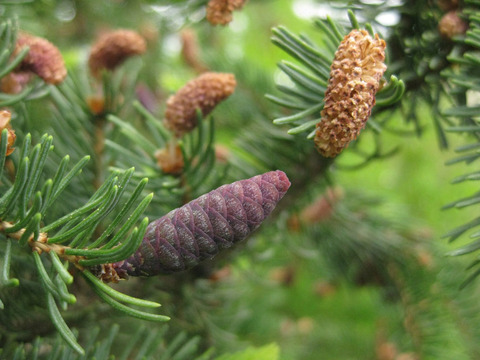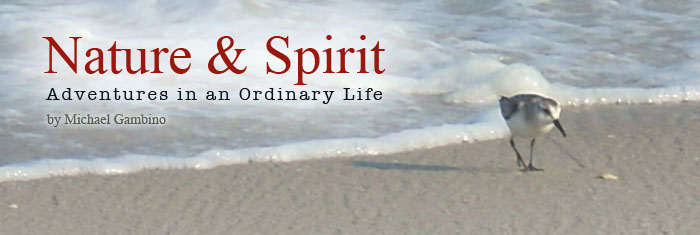Casting Fate to the Wind
 Tuesday, May 24, 2011 at 12:24AM
Tuesday, May 24, 2011 at 12:24AM Although it seems an enormous long-shot that pollen from one plant can reach a receptive plant a great distance away, nature isn’t about to let fertilization be entirely a game of chance. Eons of evolutionary changes have produced an incredible array of strategies for ensuring the continuation of species within the Plant Kingdom. Wind pollination differs from insect pollination in that plants must be able to pluck the fast-moving pollen grains from the air as the wind passes by. Other species of plants rely on insect couriers to move pollen between plants.
 Female (l.) and male (r.) cones of a Red Spruce tree.Pine cones have evolved an amazingly sophisticated solution to the challenge of capturing pollen borne on the wind. Since the cone has no way of “knowing” which direction pollen will come from, it required a shape that would allow it to face all directions and varying winds. Scientists who have studied wind pollination strategies have found that the blade-like scales on the cone act like turbines that channel the swirling air in a spiral around the cone, carrying pollen to each ovule (unfertilized seed). Enveloped in this manner, there is a higher probability for pollen to reach most of the ovules on the cone. However, there is another problem that needs to be solved – how to keep the pollen from being blown away in the process. It turns out that this vortex has an undercurrent of air where the pollen is decelerated enough to float down small air channels to the waiting ovules.
Female (l.) and male (r.) cones of a Red Spruce tree.Pine cones have evolved an amazingly sophisticated solution to the challenge of capturing pollen borne on the wind. Since the cone has no way of “knowing” which direction pollen will come from, it required a shape that would allow it to face all directions and varying winds. Scientists who have studied wind pollination strategies have found that the blade-like scales on the cone act like turbines that channel the swirling air in a spiral around the cone, carrying pollen to each ovule (unfertilized seed). Enveloped in this manner, there is a higher probability for pollen to reach most of the ovules on the cone. However, there is another problem that needs to be solved – how to keep the pollen from being blown away in the process. It turns out that this vortex has an undercurrent of air where the pollen is decelerated enough to float down small air channels to the waiting ovules.
There are other equally stunning examples of plant adaptations for improving odds of pollination by wind. For example, in studies using wind-tunnels and high-speed photography to observe exactly how pollen behaves as it flies by, the jojoba plant revealed that each set of paired leaves direct the wind in a downward channel and into the waiting bell-shaped flower that hangs beneath the leaves.
 It’s terrific that such plants have developed sophisticated methods for ensuring that the pollen arrives where it’s needed, but how is it that jojoba pollen sails right past pine cones and onward until it encounters another jojoba plant? Similarly, pine pollen won’t be caught by jojoba plants. Foreign pollen grains just blow right by, their ultimate fate lying somewhere in the distance. Studying the pollen of various plant species under the microscope reveals grains of pollen of many different shapes. These different shapes all behave differently in the wind, and are “immune” to the specialized vortex/capture methods of non-compatible species. Some grains of pollen are larger than others. Some are balloon-like, others may have fins or spines, and some look like tiny footballs. These seemingly minute variations in shape and size ensure that a round peg won’t accidentally end up in a square hole, so to speak. Scientists have surmised that wind-pollinated plant species and their pollen shapes have developed together as one system, with evolution favoring the most effective plant/pollen strategies.
It’s terrific that such plants have developed sophisticated methods for ensuring that the pollen arrives where it’s needed, but how is it that jojoba pollen sails right past pine cones and onward until it encounters another jojoba plant? Similarly, pine pollen won’t be caught by jojoba plants. Foreign pollen grains just blow right by, their ultimate fate lying somewhere in the distance. Studying the pollen of various plant species under the microscope reveals grains of pollen of many different shapes. These different shapes all behave differently in the wind, and are “immune” to the specialized vortex/capture methods of non-compatible species. Some grains of pollen are larger than others. Some are balloon-like, others may have fins or spines, and some look like tiny footballs. These seemingly minute variations in shape and size ensure that a round peg won’t accidentally end up in a square hole, so to speak. Scientists have surmised that wind-pollinated plant species and their pollen shapes have developed together as one system, with evolution favoring the most effective plant/pollen strategies.
The shapes and sizes of flower, leaf, pollen, and the deployment of them on the plant, must all function as a single unit for successful pollination to occur. It is apparent to me that an innate intelligence is at work here that, over a great expanse of time, arrived at improved methods of plucking pollen from the breeze. Now imagine how many different wind pollinated plants there are, and all their unique grains of pollen blowing around on the same warm breezes of spring! Like many of nature’s mysteries we encounter, we are left to ponder the even greater mysteries behind those that have been explained by science. Einstein is quoted as saying that there are two ways of viewing life; one way is as though nothing is a miracle, and the other way is that everything is a miracle. I hope this article gives you something to contemplate as you gather the pollen from the wind with your nose this spring!

Reader Comments